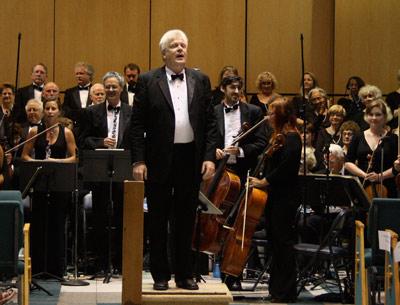Opinion: Haydn Would Have Been Proud

When George Frederic Handel presented his newly composed anthems for the coronation of George II and Queen Caroline in Westminster Abbey in 1727, the Archbishop of Canterbury is said to have commented, “The Anthems in confusion; all irregular in the music.”
Poor George Frederic. There’s nothing about his masterly compositions that should evoke confusion or the accusation of irregularity, so unless the good archbishop was tone-deaf (always a possibility), we can only conclude that, with all the resources of London at his disposal, Handel must have had a disastrous performance. Too bad he couldn’t have made it over to the colonies, where, 285 years later, he would have heard his thrilling celebration music done up right in performances that were inspiring in their clarity, cohesion, and dynamic.
Not only that, he would have heard a stirring performance of a masterpiece by his great successor. The so-called “Lord Nelson Mass” of Franz Joseph Haydn (who called it a “mass for troubled times” — also sometimes translated as “mass in a time of war”— reflects the unsettled period of the Napoleonic wars.
How did Lord Nelson’s name get attached to this work? Haydn had recently had two very successful sojourns in London but this piece was written after his definitive return to Austria. Nelson’s naval victories over the French made him a big hero in Vienna, and the British admiral is said to have met Haydn on the occasion of a visit to Austria in 1800, only a couple of years after the piece was written.
Nelson may even have heard a performance of the Mass to which his name has become permanently attached. The Handel pieces were attractive, but the focus was on the Haydn, a veritable musical monument in more ways than one.
This is not just conventional religious music. It is often regarded as a very symphonic work, but it’s also a dramatic vocal piece, with stunning music for voices. It starts out in an atmosphere of minor-key doom and gloom but ends up in the sunshine of an almost operatic finale that is all light and joy; in between, there is a kind of narrative thread that never loses its forward motion. There are no true songs or arias, but Haydn uses the vocal quartet to set off the clear shimmer of solo voices against the powerful responses of the chorus, a kind of musical chiaroscuro, of which he was a master.
In Saturday’s performance by the Choral Society of the Hamptons, the solo quartet was dominated by the angelic lead voice of the soprano Anita Johnson, a perfect vehicle for the classical ring of Haydn’s melodic inventions; her inviting calls often provoked a thrilling response from the chorus. There were also strong contributions from her colleagues in the quartet: the mezzo, Charlene Marcinko, the very elegant-voiced tenor Eapen Leubner (who, let it be noted, sang holding an iPad instead of the traditional vocal score), and the bass, Eric Johnson, a last-minute fill-in for the originally scheduled singer. Mr. Johnson’s voice sounded a little worn at times but otherwise he blended in with his colleagues as though he had been singing with them all his life.
I don’t know where the musicians of the South Fork Chamber Ensemble actually come from but, aside from an occasionally hesitant string sound, they constituted a strong and musical counterpart to the voices, with oboes playing major solos in the Handel pieces (which included an instrumental excerpt from the oratorio “Solomon”) and trumpets and organ taking equally important roles in the Haydn.
Haydn’s employers, the Esterhazys, were on an austerity kick and their entire wind section was laid off; however this didn’t seem to bother Haydn, whose telling orchestration for strings, trumpets and drums, and organ was, except for a couple of moments of disparity with the somewhat distantly placed organ, a big part of the success of the evening.
The Choral Society does not go back to Handel’s or Haydn’s time but it is one of the East End’s most durable and praiseworthy modern institutions; it was founded in 1946 and has thus passed the three-quarters-of-a-century mark. It manages to represent traditional culture in fast-moving times without losing its contemporary feel. And it maintains its status as an amateur community organization without sacrificing musical quality, beauty of sound, rhythmic energy, or accuracy.
Mark Mangini, the conductor, seems to have solved one of the perennial problems of amateur choruses — weakness in the tenor section — by adding mezzos to the high-voiced men, achieving a solid balance of the four vocal sections. The singing always had forward energy and depth of feeling combined with clarity and sound quality.
Mr. Mangini is a quiet, non-showy presence on the podium but he had a solid and clear command of both vocal and instrumental forces. The parish hall of East Hampton’s Most Holy Trinity Church has a bright sound that let the contrapuntal voices of these works shine through. And I have the impression that the presence of a large and enthusiastic audience galvanized the performers and helped turn a solid but potentially overwhelming challenge into a dynamic and communicative reading of a major work that caught its vocal, symphonic, and theatrical character, always in good measure.
Eric Salzman’s “Big Jim & the Small-time Investors” had its first coming-out this spring in a Center for Contemporary Opera workshop at the Flea Theater in New York City. His early prize-winning “Civilization & Its Discontents,” co-written with Michael Sahl, has just been released by Labor Records. “The Nude Paper Sermon” with actor Stacy Keach and the Nonesuch Consort is scheduled to be out in the early fall. “The New Music Theater: Seeing the Voice, Hearing the Body,” Mr. Salzman’s pioneering study of new and experimental opera and music-theater, was written with Thomas Desi of Vienna and is published by Oxford University Press.
